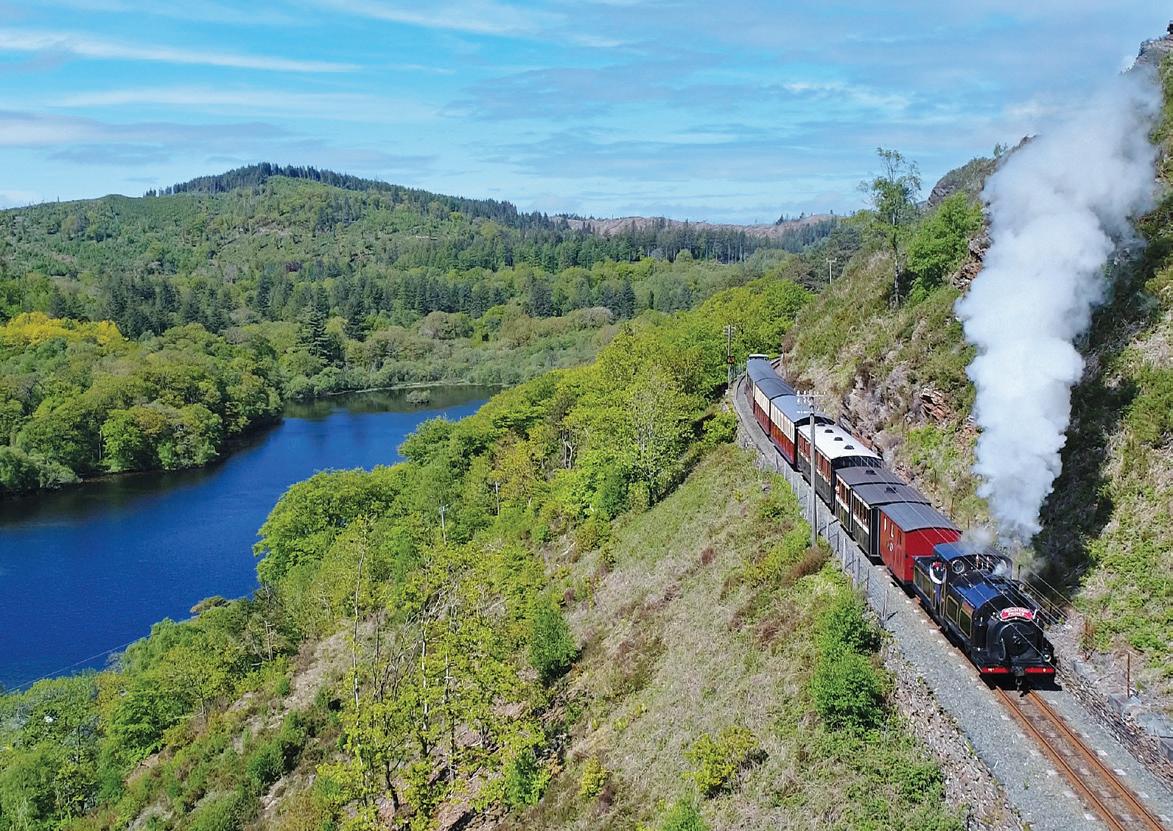Ffestiniog & Welsh Highland Railways
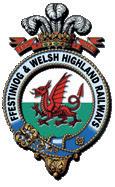
The Regenerative Railway

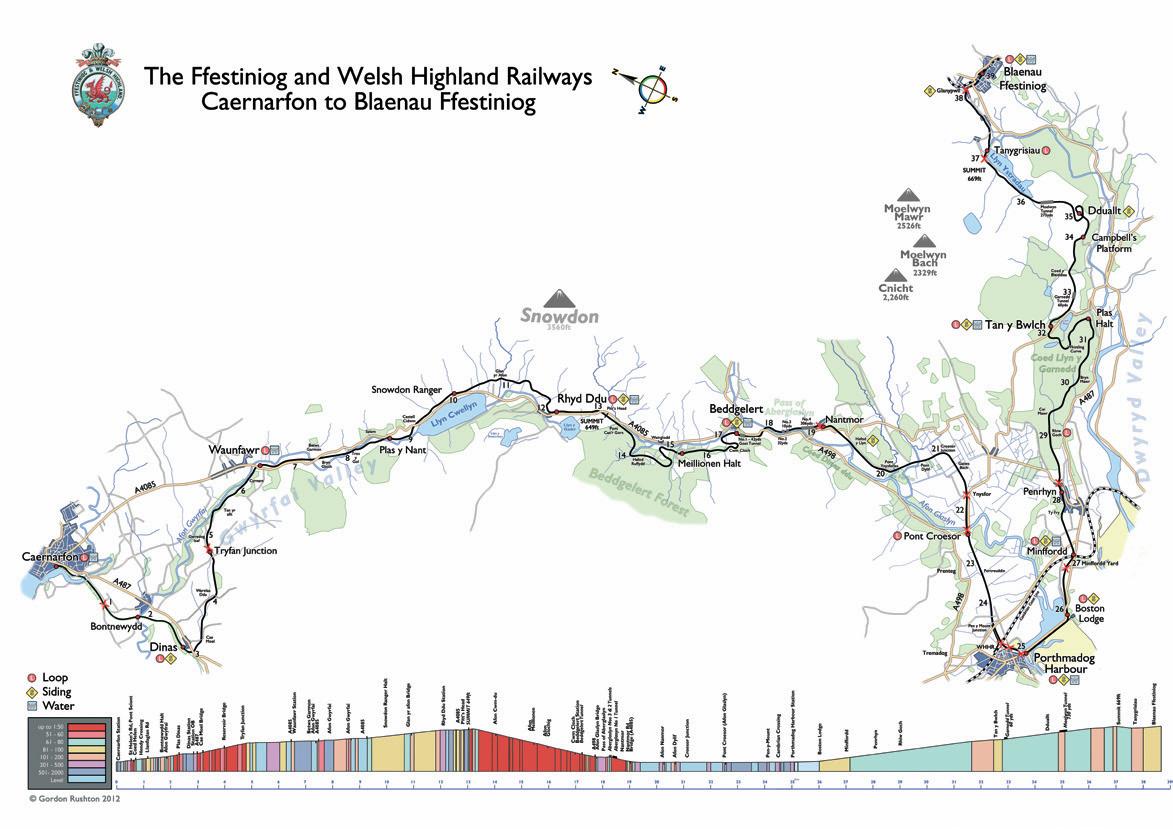
2
Our Vision and Our Intent
The intent of the Regenerative Railway is to leave the Ffestiniog & Welsh Highland Railways in a better state than found.

To develop the railway sustainably without losing that which is excellent and which we have inherited from previous generations.
As a consequence, we will pass on to future generations a railway which is thriving, rewarding to supporters, neighbours, and customers, and well positioned for its third century of operation.
3
Introduction – From Sustainable to Regenerative
Our current strategy – ‘Ffestiniog & Welsh Highland Railways – A Sustainable Future’ was published in 2011. Usually called ‘The Sustainable Railway’, it became and has remained the railway’s vision statement.
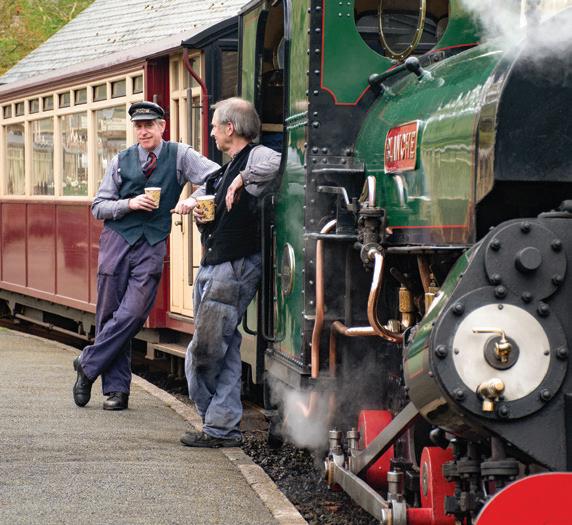
The Sustainable Railway shaped our planning over the past eleven years. Supporters – including both Societies – endorsed it.We have not seen any need to change it, other than to fill one gap.The original document said little about people and their behaviours. Behaviours reflect core values. A supplementary document ‘Values & Behaviours’ was added. This has now been revised to form an integral part of this new strategy. A series of projects and actions have helped turn the original vision into reality. As much of the work specifically identified in the project list ten years ago has now happened the Sustainable Railway is beginning to show its age as a statement of purpose.
It is time to revisit our vision.
Our railways will celebrate a series of notable anniversaries during the next decade. 2022 marks both the centenary of the first passenger trains on the original Welsh Highland, and 25 years since the first section of the new railway opened. This is followed by the centenary of the opening the Welsh Highland throughout in 2023 and culminates with the bicentenary of the Festiniog Railway Act of 1832. Ten years ago, the focus was on sustainability. Sustainable Development is formally defined as ‘development that meets the needs of the present without compromising the ability of future generations to meet their own needs’.
We thought then that this standard definition did not fully reflect our own priorities and conservation purpose. So, we added ‘and without losing that which is excellent and which we have inherited from previous generations.’
The Sustainable Railway was published several years before the Welsh Government enacted the statute that makes the welfare of future generations an explicit objective for Wales as a whole. Acknowledging the needs of future generations in this way seemed quite advanced ten years ago. However, ‘sustainable’ remains a non-negative aim. The next step is to move from being non-negative to being positive – from not compromising the future to actively seeking to leave the railway in a better state than we found it. There is no generally used adjective to describe this step – certainly not in a railway environment.The nearest – now in general use in agriculture and medicine – is regenerative. The sense is to improve the basics – not just deal with symptoms. The Oxford English Dictionary definition is ‘restored to a better state.’
Regenerative subsumes sustainable – but takes the concept a step further and increases the focus on people. That is the step we are now taking. This vision paper
comes in three parts. Part One sets out what ‘The Regenerative Railway’ aims to do. How well this vision actually works depends on people and how they behave. Part Two sets out the Values and Behaviours that the railway has adopted. Finally, readers and supporters have every right to ask what credence they can place on vision or strategy statements published at ten year intervals.Therefore, Part Three is a retrospective – it reports on the outcomes of our previous strategy – the Sustainable Railway.
4
Part One – The Regenerative Railway

1.1 Broad Objectives
Our aim is to provide a better tomorrow without losing that which is excellent and which we have inherited from previous generations. In this way, our actions benefit future generations.
The railway only exists because people enjoy and appreciate it. It is not a conventional commercial activity. Nor is it something like drains or a power supply that provides a basic need. The railway is here because people want it to be. It is a volunteer and donor run railway. It can only continue to exist providing those donors and volunteers feel that their contributions are recognised and well used. Our future depends on people enjoying the railway so much that they are attracted to see it, to volunteer on it, and to help sustain it.
The Sustainable Railway expanded the scope of the railway’s conservation priorities. Locomotives and the route itself had always been centre stage and the Sustainable Railway gave heritage carriages, waggons, and buildings similar status.The infrastructure – bridges, boundary walls and other structures – is as much a part of our heritage as locomotives, rolling stock, and buildings and will now be acknowledged as having equal heritage value. Our World Heritage vision (included with the bid to UNESCO) committed us to maintain, conserve, and operate the Ffestiniog Railway… in such a way as to retain its historic significance, character, and ambience. Cadw will inscribe part of the formation as a Scheduled Monument as part of the process. The World Heritage Site applies to just one of our railways but we will treat both as equally valuable. The restoration of Plas y Nant bridge on the Welsh Highland Railway to modern standards but in historic form exemplifies this. It is an iconic structure but it is neither listed nor within the World Heritage Site.
Both Sustainable and Regenerative are normally measured in terms of economic, community and environmental effects.The progression from sustainable to regenerative raises standards in each of these areas, but these three criteria remain the benchmarks to judge by. The next four sections outline our vision under these criteria. This is followed by sections listing firstly, major initiatives and secondly, the projects that we intend to carry out to turn the vision into effect.
1.2 Economics
Unless a railway is economically viable it cannot afford to continue operating – let alone improve or achieve anything else. So, the state of our finances is the obvious starting point.
The railway has established a sound financial position. Our experience in 2020 and 2021 demonstrated the risks of relying on an overdraft every year to address the seasonality of the business. Our objective now will be to build up a reserve and eliminate the need for an overdraft to cover cash needs during winter. The overdraft facility will then become a provision of last resort – an insurance against major risks. Our income streams can be divided into two parts.The first is revenue from trading and the second funds received from donations, legacies, grants, and contributions from the Travel Company and the Societies.
We see these two income streams differently.
Our core revenue comes from those who visit and travel on the railway. This is a large and diverse group of people – over 200,000 each year. The railway is within and forms an important element of the new UNESCO ‘Slate Landscape of Northwest Wales’ World Heritage Site and provides a major gateway to this Site. Journeys on our railway give visitors the chance to see both this World Heritage Site and Snowdonia and to understand them better. What is more, they can travel in an unusual and interesting way, be comfortable, and be looked after to the best modern standards of care throughout. Catering, retail, and external workshop contracts support the core activity. All of these activities need to be profitable in their own right.
The traditional turn-up-and-go passenger offer led to uneven loadings, with only about half the seats on offer being occupied. We moved to a fully-reserved system to meet Covid needs. This guaranteed customers their own personal space. Also, it highlighted the fact that our customers want to choose from a variety of experiences – from a full day-out return journey on the Welsh Highland to a shorter ride, or even a look behind the scenes at a selected part of the railway.
As with any major change there are advantages and disadvantages. Presenting our offers as ‘experiences’ rather than ‘a timetable’ is not traditional and feels less spontaneous – and it is more difficult to cater effectively for short hops and unusual journeys. However, the positives are substantial. Having an assured seat has proved reassuring and popular. Train loadings and takings have improved. It has led to a big increase in efficiency.We will build on this model and add the opportunity for different
5
journeys. This will be done carefully, one step at a time, to avoid losing the gains made through pre-booking.
We expect this revenue steam to cover our annual costs and to contribute towards major renewals. Improvements lead to more assets, but this increasing asset base requires more income to pay for its maintenance. We do need to be very careful. Railways in remote areas are notoriously unprofitable, and even with the contribution of volunteers the margin each year is not large.
This margin is always reinvested in improving the railway. However, with annual receipts being close to annual costs, only a small part of the funds spent on improvements comes from this operating margin.
That has led to a rather simple form of business plan. Annual costs must be covered by annual revenues. A highly detailed budget sets out how this is expected to be achieved. We can cover many but not all major renewals within this heading.
Improvement projects are separate. Each has its own project plan with identified funding that comes very largely from donations and legacies.These come through the Trust, or one of the supporting Societies. Profits from the Ffestiniog Travel business add to the Trust funds available for development.
We earn donations and legacies by offering our supporters a cause to support which combines four attributes. Something that is not only worthy, but also exciting. Donors need to be confident that their generosity will not be wasted.We have a track record of delivering what we have set out to do, but also of delivering it in a way that is very good value for money. Good value means that donors’ gifts and legacies achieve more for every pound given.
The railway attracts many donors, including some who have sponsored complete projects, clear evidence that they consider it worthy. Appeals to the general railway world have been notably successful – so a lot of new people have found it exciting to help develop the Ffestiniog and Welsh Highland Railways.The tasks that we have taken on have been huge for an organisation of our size, but they have been achieved. It is fair to claim that we have delivered on even our most ambitious programmes. And finally, our costs are extremely low by comparison with railway industry average costs. Consequently, donors can be confident that we will make their donations go a long way. We will continue to seek external grants for initiatives and projects. In every case, funds given through the Trust and Societies provide the match funding that is inevitably necessary to convince external grant giving bodies that our projects merit support. These external grants in turn multiply the benefits of funds given by our own donors.
1.3 Community – Gwynedd
Impact on the community is as much a key criterion for assessing regenerative policy as it is for sustainability. This section looks at the local community – Gwynedd – as a whole.The next section considers the railway community within this wider definition. Academic work had already established the large and positive effect that the railway has on the more general economy of Gwynedd by the time the Sustainable Railway was adopted. The contribution exceeds £20m a year. This is confirmed by more recent work and this economic contribution is now recognised as common ground in discussion with Government and local interests.

6
Chris Parry
The jobs we create both directly and indirectly form an important part of our contribution to the wider local community.
It is not easy to find high quality jobs in Gwynedd – particularly outside the public sector.The railway is not just one of the largest employers in the area, but one that has become a noted centre of excellence in areas such as carriage building and mechanical engineering, and so offers local people the chance to develop skills that otherwise would not exist in such a remote area. Most employees stay for a long time. It is not generally realised that the majority of the railways permanent employees are recruited from the locality. Over half speak Welsh as a first language. The Trustees will continue to sponsor established members of our permanent staff who do not currently speak Welsh but would like to do so.
Moreover, the railway also supports around a further 400 jobs locally through services bought in by the railway, its staff, volunteers, and passengers.That is highly significant in an economy the size of Gwynedd’s – a major contribution to the economic strength of the community.
The railway plays a cultural role in demonstrating and interpreting the heritage of Gwynedd to both those living in, and to those visiting, North Wales.
The railway showcases the steam narrow-gauge railway – demonstrating both its early development in Gwynedd on the Ffestiniog Railway and the way in which it subsequently developed throughout the world. It reflects the achievements of many generations of local families – providing a connection with and source of pride in the achievements of previous generations. We are very pleased that the cultural benefit is increasingly acknowledged and this is demonstrated by the railway’s key role within the new ‘The Slate Landscape of Northwest Wales’ World Heritage Site. Developing further links with the local community forms part of the current NLHF supported project.

Enterprises and attractions that offer a product that is much the same everywhere dilute local identity and distinctiveness. The railway is unique and celebrates this. A local identity that is clearly defined, strongly Welsh, and largely Welsh speaking. We understand the importance of the Welsh language in our bi-lingual community, where two thirds speak Welsh.
Our donors, volunteers, and passengers, many from outside the area, fund this contribution to the local community.These funds represent a net inwards contribution to North Wales.
1.4 Community – the Ffestiniog & Welsh Highland Railways Community
The people directly involved in the Ffestiniog & Welsh Highland Railways form a distinct group within the wider Gwynedd community.The railway is a collective enterprise – it involves a lot of people and becomes very important to many.
The degree of involvement naturally varies. Between six and seven thousand have joined our supporting Societies (The Ffestiniog Railway Society and Cymdeithas Rheilffordd Eryri / the Welsh Highland Railway Society). About a thousand have become active volunteers. Most volunteers come to work on the railway – as train crew, as operators, in our commercial activities, in infrastructure (track, signalling, buildings, structures and horticulture), or in the engineering works. The railway has become so important to some families that they have chosen to make their lives in the area. Others help manage the railway. The Directors, Trustees, and Officers are volunteers – and in keeping with the traditional understanding of the word are both unpaid and absorb their own expenses. The railway has been successful in attracting people with distinguished careers in railways, management, and the professions to contribute their skills in this way. Our very generous donors – many of whom choose to remain anonymous – are heavily involved as part of our railway community.
Volunteering is central to the railway’s ethos.We have renewed our focus on this by building on the success of dedicated volunteer leaders and aim to recruit more. We have recognised the importance of increased skills training for volunteers as well as staff.This is delivered through a range of schemes – including arrangements with local schools and colleges, the very successful National Lottery Heritage Fund Skills For the Future programme, the Duke of Edinburgh’s Award scheme, and Railway Industry apprentice training. It is rewarding that participants confronted with a challenge often achieve more than they thought they could. Expanding both volunteering and our ability to train people in heritage skills are an important part of our plans. The railway can be an opportunity for hands-on involvement in a historic undertaking that remains highly relevant to today’s community.
This is a volunteer and donor-run railway.To those volunteers, donors and sponsors, the railway has become a means by which they can realise dreams. Realising dreams is hugely challenging, but the Ffestiniog & Welsh Highland Railways have proved that we enjoy such challenges and can actually make them happen. With the Regenerative Railway, donors can expect that the good work that their gifts make possible should last a long time.
A common set of core values and agreed behaviours is essential if the railway is to act consistently.These form part of this strategy. Compliance with these is not optional.
7
They are underpinned by a series of formal policies. The behaviours that everyone involved with the railway must buy into include diversity, inclusivity, and no tolerance of harassment, bullying or abuse.
1.5 Environment
Environment covers both universal issues – with a particular focus on energy and carbon use – and those specific to the landscape and ecology of the area. Concerns about environmental issues are nothing new. Fifty years ago, the railway pointed out that persuading people to view Snowdonia by train rather than car reduces negative environmental impacts.

This is an external efficiency – the railway scores in comparison with alternative forms of access to Snowdonia. An aim of the Regenerative Railway will be to add to this by improving our own carbon efficiency at a much faster rate than we have in the past. It will be a step by step process. The quickest and largest potential gains will be at stations and depots, so these will come first. New projects give us the best opportunity
to make changes. Boston Lodge Works uses more energy than anywhere else on the railway. A large photovoltaic (PV) installation on the roof of the new Large Carriage Shed in January 2022 provides the potential to meet the majority of the works’ electricity needs. It also gives us the opportunity to assess how best to build generation and storage into further projects. The design of the new Erecting Shop and other new buildings in the project list below can incorporate further PV if further capacity is justified.
Beddgelert Station is likely to be an early project in the Regenerative Railway. The design brief includes considering how we can both generate and store power on site. Work on existing buildings will always seek to improve insulation and conserve heat. Recent work on Dinas workshop provides an example of the benefits of a much better insulated roof and of a heat recycling system.The buildings restored under the current Boston Lodge project will use heat pumps for heating.
Buildings, and what goes on inside them, use a lot of energy. Train operation is the other substantial user. Over half the trains we operate are works trains. These are diesel operated. People like our diesel fleet, but also accept that it needs to be upgraded. The Board has decided to look at options to replace the main diesel fleet with battery or other low carbon power as set out below.
We are a steam railway. Steam, Snowdonia & Scenery encapsulates what appeals to visitors. Steam is a key part of that appeal – to visitors and supporters alike. A rule of thumb is that a steam-hauled train will attract twice as many passengers as a diesel train. The railway exemplifies the steam narrow-gauge railway. The World Heritage site designation recognises the contribution of such steam railways. Eliminating steam engines would put the whole railway at risk.
At present we have to use carbon to produce steam but we recognise its impact and ensure that it is used as efficiently as possible. Moving to a pre-booked railway has improved our train loadings. There are far fewer empty seats. This efficiency gain carries through to fuel use. In 2021 fuel used per passenger mile fell 30% – a large step in the right direction – and we expect to maintain or improve on this.
We will continue to keep the choice of steam fuels under review.
Catering on trains also needs power.This has previously come from diesel generators. Batteries are replacing these generators. Better for carbon, much less noisy, and a way to reduce our carbon footprint without damaging what appeals to supporters and visitors. We will use our own photovoltaic generation to charge these batteries.
Carbon is a universal issue. Most other ‘environmental’ impacts come under the general heading of public goods. These are diverse and more difficult to measure. The railway provides public goods through its heritage assets, through choosing sustainable options (for example recycled-plastic sleepers rather than ones made from African
8
hardwood), through mitigating emissions, through being part of cultural landscapes, and through protecting and enhancing the biodiversity of the areas it runs through.
At the specific level, the railway runs through and forms part of protected areas –protected by Government to reflect their intrinsic value in both cultural and ecological terms.
Sixteen buildings or structures owned by the railway are listed, as well as the Cob Embankment and Britannia Bridge that we run across. The railway runs through five Sites of Special Scientific Interest (Glaslyn, Coedydd Dyffryn Ffestiniog, Coed Nanmor, Coedydd Beddgelert a Cheunant Aberglaslyn, and Afon Gwyrfai a Llyn Cwellyn) several of which are also designated as Special Areas of Conservation. In ecological terms, the railway provides long corridors with little disturbance connecting areas of woodland or other priority habitats. We manage these sensitively. Much of the railway is within the protected landscape of the Snowdonia National Park. In cultural terms, the railways are part of the Slate Landscape of Northwest Wales World Heritage Site as well as within the Aberglaslyn and Blaenau Ffestiniog Landscapes of Outstanding Historic Interest.
This railway and its hinterland enjoy a very high level of public protection by any standards. This public protection recognises how our railways, the landscapes they sit in and their ecology, are all valuable public goods.
International recognition has come in the form of the Slate Landscape of Northwest Wales World Heritage Site.The railway’s monuments are part of that World Heritage Site. But it goes much further than that.The railway’s historic role in exporting the concept of narrow-gauge railways from Snowdonia throughout the world was highlighted to UNESCO as an indication of outstanding universal value. The railway’s current role in showing off that landscape to visitors using a key invention of the Welsh slate industry (the steam narrow-gauge railway) is seen as very important in enabling the world to appreciate the new World Heritage Site.
The award of World Heritage Site status seems a very good point to reflect on what the Sustainable Railway has achieved, and to move forward into a new vision of how the railway can make the most of this recognition.

9
A replica of an 1870s Ashbury brake-composite carriage is being built for the Welsh Highland Railway’s heritage fleet by Boston Lodge Carriage Works. (John Dobson)
The Regenerative Railway – Initiatives
People are central to the Regenerative Railway. Developing our people and encouraging better interaction is key to regeneration. The Regenerative Railway will lead to a series of initiatives each designed to improve the relationship between the railway and different key groups – not just staff but visitors and passengers, neighbours, volunteers, donors, and those who just want to be friends of the railway.
Visitors get more out of the railway if they understand its history, its volunteer and donor-run present, and its contribution to the community. Better interpretation will add value to the visitor experience and help people appreciate the story both of the railway itself and the region its serves. The delivery phase of the NLHF supported Boston Lodge, Interpretation & Development project will resource better interpretation throughout the railway, and this starts in 2022. The project is as much about interpretation, and about developing volunteering and outreach, as it is about restoration at Boston Lodge.The full title is a mouthful so the project will be referred to as the Boston Lodge project for simplicity.
As a volunteer and donor-run railway, our future depends on inspiring people to want to volunteer to work on, and to help run the railway in future. Many of our volunteers arrive highly skilled, but we could do more to provide facilities and training to build up this population. Plans for the Boston Lodge project include a training centre – opening up new opportunities for both volunteers and local outreach.The plans for Dinas and Boston Lodge Works provide designated spaces for volunteer projects. The railway will work with the Societies to encourage more volunteers, and especially more young volunteers, and to improve outreach into the local community. The Boston Lodge project funds leaders for both volunteer and outreach development. As with better interpretation, the first results should be evident in 2022.
Potential donors have a very wide choice of good causes to support. Our reputation is built on actually delivering on projects that are exciting, worthy, and very good value for money. We know that every donation has to be earned. We are very grateful for the continuing large level of support throughout the Sustainable Railway years. We hope that the initiatives and the projects described here will continue to encourage donations and legacies.
Donors can give to the railway through the Trust or either of the two Societies. Whichever route a donor chooses, they have a right to expect the same standards of probity and efficiency. All three are charities. All of our Trustees understand that the money received from donors and legacies is not their money and that they have a legal as well as a moral responsibility to ensure that donors’ wishes are acted on as effectively and quickly as possible. A range of appeals will cover all sizes of project and
levels of contribution. Our fundraising and fund allocation processes are constantly reviewed to make sure they are as effective as possible.
Society membership appeals to people who want to stay in touch with their railway. The main benefits have always been quarterly magazines and members’ travel privileges. Both are highly valued by many supporters, but we may be able to develop other ways to appeal to those who would like to be friends of the Ff&WHR in the digital age. We will work with both Societies to reconsider how best membership of their society can foster an even greater sense of belonging.
In principle the railway’s structure is straightforward. The Trust – a charity – has a controlling interest in the railway Company and acts as its owner. The Company runs the railway and owns its assets.The Societies support it.This structure will not change. New agreements will help set out how this vision will be executed collaboratively. The railway’s governance rests on pre-Victorian legislation going back to the original Festiniog Railway Act of 1832. We value this long history but recognise that modern concepts sometimes need to be addressed.We want to satisfy such needs by minimal changes to our formal structures.These changes are being enacted through a Transport and Works Act Order.
The strongest signal about who and what we are comes from how we behave – ‘by your deeds shall you be known’. The railway demands a lot of its people and those people have every right to know what sort of organisation they are committing to.
Values and Behaviours exemplify the Ffestiniog & Welsh Highland Railways’ way of doing things. The original version followed much consultation and this content has now been expanded. For everyone who wants to be directly involved with the railway, these Values and Behaviours give an insight into how we manage relationships. They are set out as Part Two of this vision document.
10
BOSTON LODGE WORKS PLAN

A Works Access Road
B Works Car Park
C Top Yard Heritage Buildings
D Erecting Shops
E New Small Locomotive Shed
F Old Carriage Shed
G Heritage Rolling Stock Shed
H New Large Carriage Shed
I Carriage Works
J FR Locomotive Running Shed
K Carriage Works Proposed Extension
11
The Regenerative Railway – projects
The funds for development come largely through legacies, donations, and sponsorship, and the grants that those gifts release when used as match funding. So, it is essential that our future aspirations and programme are exciting enough to attract donors.
Boston Lodge
Restoring the historic core of Boston Lodge is a major part of the NLHF supported project. This includes £3m for restoring buildings, including creating training, messing, and office space, and a locomotive shed for the smaller Ffestiniog engines. This will keep us very busy for several years. Once this is done, attention will turn to restoring the 1900-built ‘new’ erecting shop, replacing the 1970s erecting shop that sits behind it with a larger building constructed to best modern standards, and building the new Ffestiniog and Garratt locomotive running sheds. This would complete the Boston Lodge project as currently seen. What will this cost? Probably another £2m to £3m after the NLHF-sponsored project has been completed (circa £3m).
Intermediate Stations
Beddgelert and Tan y Bwlch have become much more important destinations since Covid and this greatly improves the case for investment at these stations. A new station at Beddgelert may well be the first project started from new under the Regenerative Railway. Enabling work to improve drainage at Tan y Bwlch will be followed by the restoration of the Station House. Work on other intermediate stations will be part of the programme to restore our heritage buildings and linked to plans to operate heritage trains over relatively short sections of line.
Carriages (modern)
We had a clear idea of the number of seats we needed in the pre Covid age – it is less clear now as the new business model based on pre-booking has yet to settle down. Improving the environment where our passengers spend most of their time remains a key priority and the modern carriage programme is a very effective way of
Architects impression of the proposed new Beddgelert Station Building. (Chambers Conservation Ltd)

12
improving standards where it counts.The emphasis will probably change. For example, indications suggest an increased market for Pullman Observation cars but a lesser need for full Service Cars. Having unused modern vehicles is a waste. Some existing modern vehicles may be altered to suit new needs, others will be built new. At this stage any programme must be provisional. One new or rebuilt vehicle a year for the next 10 years would be a reasonable forecast.
Heritage Carriages and Trains

Heritage carriages came into their own providing safe segregated and reassuring accommodation during Covid. In future their appeal will rest on our being able to offer heritage trains as an experience in its own right. Shorter-distance trains are part of the offer, but could equally be operated with more modern carriages. Heritage carriages need cosseting to conserve their historic material, so their use will be carefully monitored. The Ffestiniog Railway has a remarkably complete collection of heritage carriages. Distinct NWNG / WHR heritage trains will become possible with the completion of the Ashbury Composite Brake.
Heritage Buildings / Monuments
The Boston Lodge complex has the greatest concentration of heritage buildings on the railway and these will largely be restored as part of the Boston Lodge project. Tan y Bwlch, Minffordd, and Penrhyn Stations will follow as resources permit. Dinas Goods Shed is an example of a building which is being carefully watched for signs of deterioration.
Many of the other heritage buildings owned by the railway have been modernised. The scope for sympathetic restoration will be considered as they become due for heavy maintenance. Often, work on a heritage structure is enabled by a generous donation. This achieves its core purpose of saving the structure, but in some case buildings have had to wait quite some time before finding a new purpose. We will try and reduce this time gap.
Stone embankments, top-wired dry-stone walls, distinctive wrought iron gates (such as those on the North Wales Narrow Gauge) and many other features contribute to the character of the railway. We will retain and restore such features wherever possible. Small individually, they have a great impact overall.
Major Stations
Porthmadog Harbour is the railway’s major station. It serves both railways and it is the gateway to the railway for over half of our passengers. The operating facilities were transformed in 2014. Commercial facilities need an upgrade as well. Once the Boston
Lodge Project is complete many operating functions will move there, providing room to work on Harbour. The station building is in three parts. The Station Building and the Goods Shed (now Spooner’s) are historic buildings from the 1880s, and they are joined together by a 1970s link building. The two historic parts will be re-roofed and restored. The options for the link building range from modest upgrade to complete replacement. The resulting work is likely to be scheduled for the later 2020s or early 2030s.
Blaenau Station is an interchange with Transport for Wales / Network Rail and forms (a small) part of the station upgrade plan for the whole of Wales. Good progress was being made before Covid led to the whole programme being revised.We will continue to work with Transport for Wales and Network Rail to build a better interchange here. At Caernarfon we aim to provide covered links to take passengers from the magnificent new Station to the platform and train. The contrast at present is quite extreme.
13
The elegant interior of the FR’s Pullman Observation Car No.150 illustrates the high level of craftsmanship achieved by Boston Lodge Carriage Works (Andrew Thomas)
DINAS NORTH YARD
A Existing Carriage Shed
B Store
C Store
D New Carriage Shed
E Old Goods Shed
F Dinas Station Building
DINAS SOUTH YARD
A Dinas Locomotive Workshop
B Locomotive Servicing Point
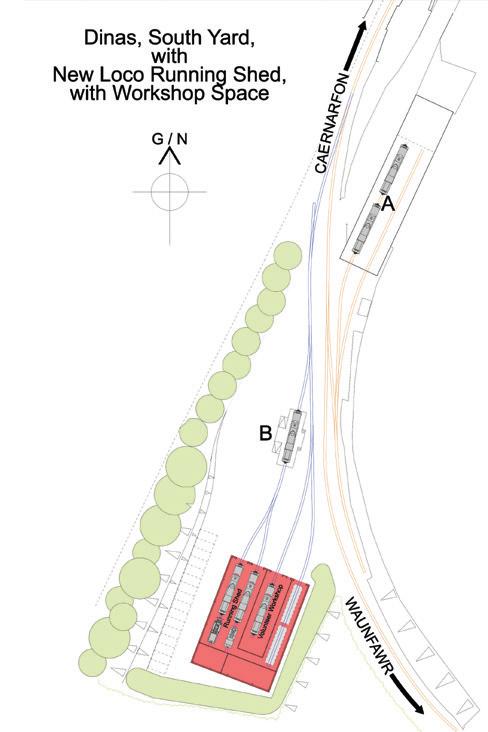

14
Dinas
The present arrangements for handling trains between Dinas and Caernarfon lead to a lot of shunting.This is inefficient and results in unnecessarily long days for crews. Plans are well advanced for a new locomotive running shed in the South Yard, including space for storing Infrastructure machines, a volunteer workshop, and messing facilities. The machine and erecting shops will occupy all the existing building. A new carriage shed with direct access to and from Caernarfon and to the loco shed will be built in the North Yard. These new buildings will include staff facilities, and benefit from lessons learnt with the large carriage shed and small locomotive shed at Boston Lodge. All options retain a large open area in the North Yard as our infrastructure depot at the north end of the line.
Works Train Locomotives
Half of our train miles are on works trains.This presents a great opportunity to reduce carbon emissions by replacing regular diesel traction with a new fleet of battery / hydrogen or other energy-efficient locomotives.These are likely to be built so that they can work in multiple for passenger use. The first major study will be commissioned in 2022. Costs are difficult to predict at present – a £3m allowance seems appropriate.
Steam Locomotives

Steam locomotives are central to the railway but carbon consumption is a concern and supplies of suitable coal are becoming increasingly difficult. Better train loadings as
a result of pre-booking will make more efficient use of the fuel burnt, and the steam loco fleet will be adapted to burn greener fuel as and when such fuels become available. Welsh Highland trains demand powerful locomotives because of the gradients. We have worked hard to provide enough cover – and aim to have a spare Garratt boiler available. An NG15 is being restored and will be an interesting alternative to the four NGG16 Garratts.
Small locomotives have a particular attraction. Those historically used in the area are well reflected in our fleet, but there remains an appetite for restoration and for building replicas. The more we can make a success of heritage trains as a different experience the more we will have a role for historic small locomotives. We are keen that all of our locomotives are kept in good condition and appropriately accommodated. The proposed facilities at Dinas envisage stabling small locomotives there as well as at Boston Lodge. We may need to consider storage facilities in other locations as well.
Signalling
Micro ETS with interlocked starter signals is a system that is both innovative and incorporates the lessons learnt through years of safe operation on single-track railways. The system needs to be enhanced to provide for intermediate instruments and for sidings. Installation will cover the rest of the Welsh Highland and the system may be extended to the Ffestiniog as renewal become due. Having a single system itself improves safety by reducing the scope for confusion, and this is even more important with a volunteer railway.

15
To complement the NGG16 Garratts, an NG15 ‘Kalahari’ 2-8-2 is being restored for use on the WHR. (Stuart Black)
Infrastructure Equipment
During this period the railway will need to evaluate its future needs for tamping and other track maintenance equipment. The cost is likely to be high.
Track – Formation and Permanent Way
This will continue to be a priority with at least two miles of track expected to be renewed over the period of this strategy. At the moment the rate of renewal reflects the fact that the WHR track is still relatively new. Renewals will need to ramp up as WHR renewals become due but the main increase will come after the period of the strategy. Bridges and other structures are inspected regularly, and those that require attention will be funded.
Energy Saving Projects
The photovoltaic installation (50KW) on Boston Lodge Large Carriage Shed roof is the first of what will be a series of projects to improve energy efficiency and reduce our carbon footprint. These could use a range of technologies.
The railway aims to reduce its carbon footprint wherever possible. It is sensitive to the biodiversity of the areas it runs through – exemplified by their designation as protected areas – relevant projects will incorporate biodiversity needs within the design process.
Looking after our records
The need for a proper home for the records of the modern era has become acute –these are needed to inform current decisions as well as providing the archive of the future. We will aim to commission a suitable building as soon as possible.
A first cut at what this might cost
Estimating such a programme is difficult, both because these proposals are at an early stage of development and because inflation can rapidly make specific figures obsolete. The programme above would cost £25m - £30m at 2022 prices. How quickly this programme can be delivered depends on a number of factors –including the economy and how successful we are at attracting legacies, donations, and grants.The direction is clear. Our approach to planning means that each major project has its own plan, so they will only be activated when the funds are available.Timescales can be flexible. This programme will probably take ten years or slightly more.
The Regenerative Railway –Conclusions
This concludes the first part of this vision paper. It explains what ‘The Regenerative Railway’ aims to do over the next ten years, and the initiatives and projects that will help achieve these objectives.

How well this vision actually works depends on people and how they behave. As a collective enterprise, the railway relies on a lot of people wanting to be part of it. How people behave has as much effect on other people’s enjoyment and welfare as what we set out to do.
We are proud of and value the people who are part of our railway. Our intent is to improve wellbeing and welfare. Training, mentoring, and development have an important role to play. But success will be critically dependent on everyone involved with the railway making the effort to understand what is expected from them, adopting the values that express this understanding, and actively avoiding negative behaviours. So, these values and behaviours are not optional. They are part of the management process, backed up by formal policies, and adherence will be part of annual reviews. The Values and Behaviours are best set out in a tabular form and follow this section.
Finally, readers and supporters have every right to ask what credence they can place on a vision or strategy statement published at ten year intervals.Therefore, Part Three is retrospective – it reports on the outcomes of our previous strategy – the Sustainable Railway. The results? Financial stability achieved because long term debt was repaid. The railway’s contribution to the economy of our community – Gwynedd – widely acknowledged. Inclusion in The Slate Landscape of Northwest Wales World Heritage Site marking our contribution to environment and heritage. A substantial list of major projects have been completed. We have invested more than forecast eleven years ago and done so using funds raised for the purpose without recourse to borrowing.
I hope this evidence that the railway delivered over the last eleven years provides confidence that it can continue to do so. Over many years the railway has shown that it can reinvent itself to adapt to a changing world without losing its essence. The Regenerative Railway will not just conserve this very special railway but do so in a way that should make it even better for future generations. I hope that this is something you will want to support – by doing so you will be part of something quite special.
Dr John Prideaux, CBE Chairman, Ffestiniog & Welsh Highland Railways Trust Chairman, Festiniog Railway Company, October 2022
16

17
The Permanent Way Team’s Wickham Inspection Trolley became the FR’s first battery-electric powered vehicle in August 2022. (Roger Dimmick)
Part Two – Values and Behaviours
The Ffestiniog & Welsh Highland Railways are well known for their remarkable history and ambience, but it is the tremendous reserves of knowledge and dedication amongst our staff, both paid and volunteer, that makes the F&WHR really stand out. We feel that, when people join the F&WHR, we need to be in a position to quickly answer the following major questions:
• What sort of organisation is this?
• What is important to the organisation?
The panels on the following pages aim to capture what matters to us right across our organisation, and to map out how we expect people to behave.The central panel in each case shows what we consider to be effective behaviour, and there are illustrative examples of too much or too little emphasis on particular courses of action.
These values come not only from the Company Board or the Ff&WHR Trustees but from everyone in our organisation. We collected opinions and suggestions from a very broad cross-section of our people, both volunteer and paid staff, long-serving or newcomer. These are reflected in this document for everyone to see.


People often mention the F&WHR way of doing things.This document aims to capture that ‘way‘. We hope it is useful, believe that it is important to our future success, and expect it to be used as a clear guide as to how everyone should behave in their work for the F&WHR.
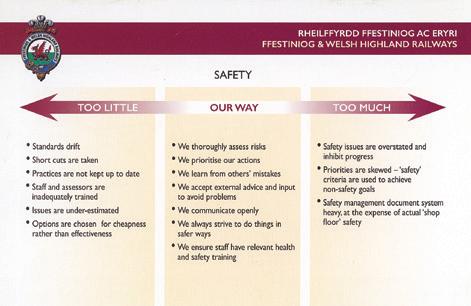
18

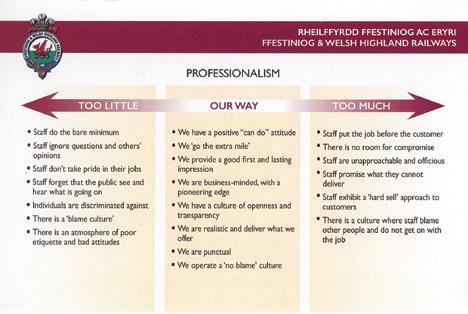

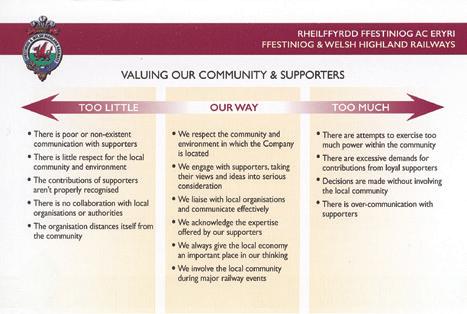
19
INCLUSION AND DIVERSITY
TOO LITTLE TOO MUCH
• Not challenging non-inclusive attitudes and behaviours
• Taking easy recruitment options
• Leave it to others “it’s not my problem”
• Stay in a comfort zone
• Only talking to those we know
• Not committing time and resources to building a network
• Not taking time to understand needs
OUR WAY
• Creating a welcoming and safe space where all are respected and valued
• We value inclusion and diversity
• Proactively seek to continue to interest a diverse range of people
• Taking a team approach to diversity and helping others understand
• Growing a strong network, seeing opportunity and opening perspective
• Over emphasise diversity to the exclusion of other needs
• Missing out on talent in a drive for diversity
• Too much emphasis on individual views; expecting one person to speak for all
• Lose sight of the business needs
• Insufficient attention given to current team members
• Too much attention given to an individual rather than team needs
BULLYING & HARASSMENT
TOO LITTLE TOO MUCH
• Ignoring offensive banter
• Not being vigilant about the signs that bullying is happening
• Tolerating individuals who choose not to adopt our Values and Behaviours
OUR WAY
• We call out poor behaviours and take complaints seriously
• We take care to protect complainants and those complained against
• We understand that people all have different sensitivities and tolerances
• Constraining development and contributions through excessive challenging and questioning


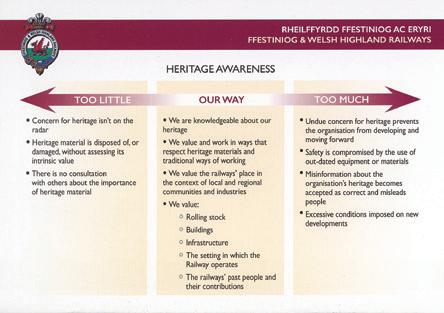

20
Part Three - A Retrospective
How did we do during the Sustainable Railway Years?
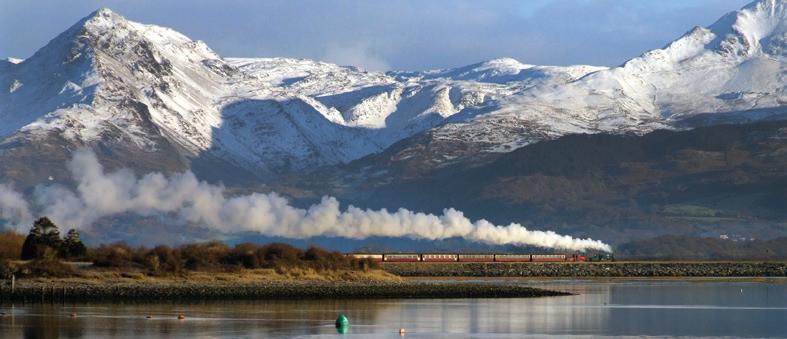
Achievement can be measured in several ways. In the following paragraphs we look at the broad picture, then consider whether the Sustainable Railway delivered on the specific projects identified eleven years ago.
The criteria used to judge sustainability are the same as for regenerative action –economics, community, and environment.
To become sustainable required us to develop the railway to meet today’s needs in a way that did not compromise the ability of future generations to meet their own needs.
Our aim was a railway fit for purpose in the twenty first century – fit for purpose in a way consistent with being leaders in conservation. The route did not change; but improvements to the facilities that make a railway work such as stations and depots did change and we provided much better carriages for our customers to travel in.
The railway had built up substantial long term debt by the early 2000s, peaking at £1.75m in 2003 and the railway was still heavily indebted eleven years ago. Long term debt has now been eliminated.
The Sustainable Railway has successfully covered its ongoing costs from the income
and donations it generated. If it had not, then debts would have increased and for any Company that is unsustainable in the longer term. We made a modest surplus every year. The objective has been to provide a cushion for factors beyond our control such as the weather, and the state of the national economy, whilst providing some contribution towards major renewals and improvements.
The railway improved what it offers its customers and supporters. How this happened is tied up with specific projects and is described in the next section. In general terms, our carriages improved greatly, becoming arguably the most comfortable on any heritage railway.Train service pattern stabilised with similar earnings on both railways. Earnings per train were good by industry standards. Ancillary activities – catering and retail – fluctuated. Facilities – such as workshops and stations – have been tackled step by step. Our works built up a reputation for quality that has generated orders for carriages and other work from other railways throughout the UK
The large programme of works carried out over the past eleven years under the Sustainable Railway has been funded without borrowing.The rule is now quite simple.
21
Roger Dimmick
We do not spend money that we do not have.
This business model has worked well for most of the Sustainable Railway years. But, in more recent years our costs have risen faster than fare levels leading to a squeeze on margins. This has applied particularly to wage costs – largely as a result of Government policy.
The railway retained short-term debt in the form of an overdraft throughout the sustainable railway years.Year after year we have used up most of our overdraft facility by early April – and then saw this reduce as revenues built up from Easter onwards. The reflects the fact that the railway spends throughout the whole year but earns most of its revenue in seven months.
Covid meant that we had to close four days before the season was due to start in 2020. The revenues expected to pay down that overdraft never came. Loans from the Trust and both Societies were arranged at very short notice. All parts of the railway pulled together without fuss or argument and this enabled the railway to survive the completely unexpected shock caused by the pandemic. Covid did lead to an exception to our general rule that donations are used for improvements. Most of the emergency funds given by supporters did go to fund core expenses that we would otherwise have funded from revenue. It is our intention that this should remain an exception.
The projects we listed eleven years ago
The Sustainable Railway included an outline project list – with notional estimates. The list was to be delivered over ten years. Our supporters deserve to know how far these projects have been delivered.
Porthmadog
Remodelling Porthmadog Harbour Station was a major job including extending the station footprint with a widened embankment and new wave wall, major track changes, a new platform with Ffestiniog & Welsh Highland Railways on opposite sides, and resignalling. It was completed in 2014.
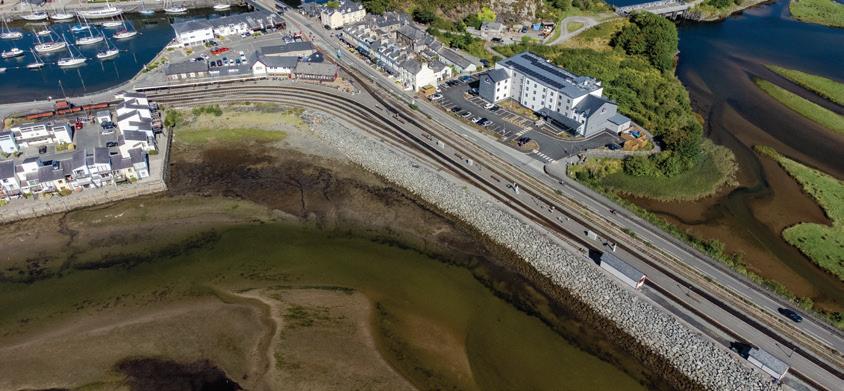
Boston Lodge
New carriage and locomotive sheds were included in our project list – but not the preliminary work that would be necessary at Boston Lodge before work on these facilities could start.
The conservation challenge is huge and the site very cramped, so finding space for the necessary facilities was also tremendously challenging. In practice we have worked from the periphery towards the centre to ensure that the site could continue to operate
22
The greatly expanded layout at Harbour Station can now accommodate up to three passenger trains at the same time. (Dave Thurlow)
while reconstruction took place. Some activities have been moved away from Boston Lodge both to provide better facilities for those activities, and to make enough room for those things we could not move.
The site lacked proper access – or services like drainage to anything like modern standards. These issues had to be resolved before anything else could happen. The enabling works have included new road access, parking, a new drainage system to modern standards and a sea wall. As well as these fundamental enabling works, we have moved infrastructure activities to Minffordd, extended the site, built a new carriage shed for heritage carriages, completed the large carriage shed (which lives up to its name and provides a running shed for three trains / 30 carriages) and restored one of the heritage buildings (The Blacksmiths’ Shop) for volunteer use. This is a good start and represents nearly £3m, all of which has come from donors. The completion of the Boston Lodge project, which sets out to simultaneously restore our heritage and provide new facilities to a high standard, will be an aim of the Regenerative Railway.
Minffordd
In 2011 Minffordd was full of decaying trailers and containers used for storage, and of waggons and other heritage material left in the open. The trailers and containers have gone, replaced by a new workshop, mess, and storage sheds. Our 200 heritage wagons – many previously in the open – now have a home in the heritage wagon shed.
Historic Buildings
Work on restoring Ffestiniog Railway heritage buildings started in 2008 with the Old Locomotive Shed at Boston Lodge. Minffordd Goods Shed and the Blacksmiths Shop at Boston Lodge have been restored under the Sustainable Railway. Restoration of a large proportion of the railway’s remaining heritage buildings is included within the Boston Lodge project.
Blaenau Station
Blaenau is an interchange station shared with Network Rail / Transport for Wales. The idea of developing our own scheme was overtaken by improvements planned by Transport for Wales. Timescales for that project have been affected by Covid and are uncertain. The principle of fitting in with Transport for Wales national plan for stations remains valid.
New Diesel Locomotives
We have not bought or built any. This was on the list as something to do in later part of the plan. The world has changed and the Regenerative Railway will look for a different way forward.
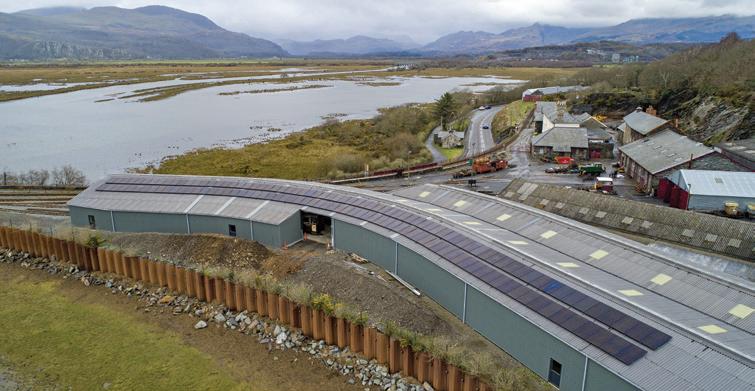
23
This photoelectric array on the New Large Carriage Shed at Boston Lodge will supply much of the power required by the Works. (Dave Thurlow)
Ten New or Completely-rebuilt Carriages
We have significantly exceeded this objective – with 18 new or substantially rebuilt carriages. We have built ten new FR carriages (Nos.103, 108, 117, 118, 119, 120, 125, 150, 152 and 808), four new Welsh Highland carriages (Nos.2046, 2047, 2048, and 2152) and carried out three major rebuilds of WHR carriages (Nos.2091, 2040, and 2042). At the same time a replica of FR carriage No.21 has been completed as a sponsored volunteer project. The nominal sum provided was £1.2m – actual spend £2.1m, all of which came from donations, Company profits, or Ffestiniog Travel profits.
Caernarfon Station
The Portacabins have gone – replaced by a splendid new station on a very sensitive site next to Caernarfon Castle; itself a segment of a World Heritage Site. The station is not on an old station site – it is of its time and was designed to do what is needed in a way that complemented both the medieval Castle and the Victorian embankment behind the station. It was opened by the Chairman of the National Lottery Heritage Fund in 2019.The actual cost was £3.15m, two thirds of which came from Government grants. (The nominal sum of £1m shown in the Sustainable Railway proved a substantial underestimate)
Dinas
In 2011, half our present Erecting Shop belonged to Dwr Cymru. This was purchased and converted into railway use. The whole of this building has since been reroofed, with heating improvements. But major improvements remain to be done. Dinas will be a priority for the Regenerative Railway.

Intermediate Stations
The economic case for spending large sums on intermediate stations has been weak, simply because during the Sustainable Railway years most passengers travelled the whole length of the line. However, many intermediate stations and buildings are important historically and add character. New standards have been set by what has been accomplished. A new station was opened at Waunfawr on the same day as Caernarfon Station. The railway house at Coed y Bleiddiau has been restored in collaboration with the Landmark Trust. This may not be a station in the formal sense but it is both an occasional stopping point and a prominent landmark on the Ffestiniog.
Signalling Improvements on WHR
A very innovative system (Micro-ETS), invented by one of our supporters, has been installed between Porthmadog and Rhyd Ddu. This combines digital technology with the proven (initially Victorian) Electric Token System and with interlocked starting signals to safely control single lines.
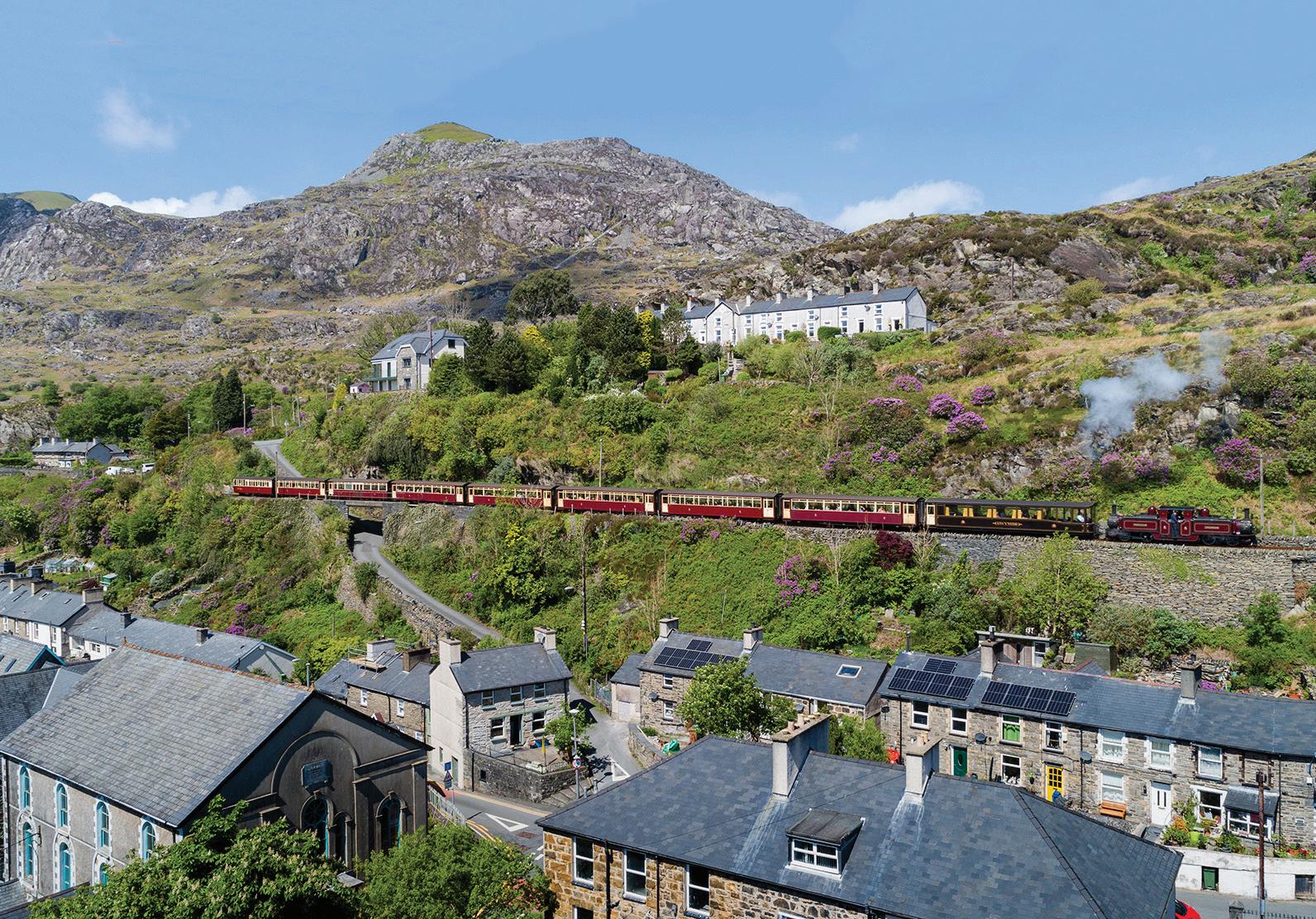
Total Investment
Our total investment has been £10.5m. By comparison, the notional estimate shown in the Sustainable Railway in 2011 was £8.6m
John Prideaux
24
An aerial view of Minffordd Yard reveals the rebuilt Goods Shed and new Waggon Tracks shed (left) the new Infrastructure Workshop (centre), and two new storage sheds, all built since 2011. (Dave Thurlow)

25
The Ffestiniog Railway is an integral part of both the rural and urban landscapes as it threads its way through Tanygrisiau. (Dave Thurlow)
How you can help
The railway has survived and developed through the generous support of many people. We hope that you will want to help. There are many ways of helping. These include making a donation, leaving a legacy, becoming a volunteer, joining either of our two supporting societies, or taking a holiday through our travel company. The following contacts can help you take the next step.
To donate or contribute to the appeals aimed to realise the projects outlined in this vision:
Contributions should, please, be sent to the Ffestiniog & Welsh Highland Railways Trust / Ymddiriedolaeth Rheilffyrdd Ffestiniog ac Eryri (Registered Charity No 239904)). Please make cheques payable to ‘Ffestiniog & Welsh Highland Railways Trust’, and if you are a UK taxpayer, ask for, or enclose a gift aid declaration, and send them to: J Scarisbrick, Treasurer, Festiniog & Welsh Highland Railways Trust, Harbour Station, Porthmadog, LL49 9NF jscarisbrick@ffwhr.com
To enquire about sponsorship or to leave a legacy
The Secretary, Ffestiniog & Welsh Highland Railways Trust, Harbour Station, Porthmadog, Gwynedd, LL49 9NF (Registered Charity Number 239904). rholton@ffwhr.com Legacies should be made out to the Trust at the above address, please.
To volunteer
If you have volunteered before please follow existing procedures (if in any doubt contact your volunteer team leader or department manager). If not please contact Iain Wilkinson, Harbour Station, Porthmadog, Gwynedd, LL49 9NF. (iwilkinson@ffwhr.com)
To join or donate to the Ffestiniog Railway Society
Registrar: M W Cowgill registrar@ffestiniograilway.org
To join or donate to Cymdeithas Rheilffordd Eryri / The Welsh Highland Railway Society
Membership Secretary: Richard Watson rwatson@chre.uk 01328-853144
To take a holiday through Ffestiniog Travel www.ffestiniogtravel.com
Ffestiniog Travel is owned by the Trust and all profits go into the general fund of the charity. Every holiday you take with Ffestiniog Travel helps both railways. It is the only railwayoriented travel company owned by a charity, as well as the only one in North Wales.
Supporting Ffestiniog Travel helps maintain employment in rural North Wales as well as the railway. info@ffestiniogtravel.co.uk +44(0) 1766 512400
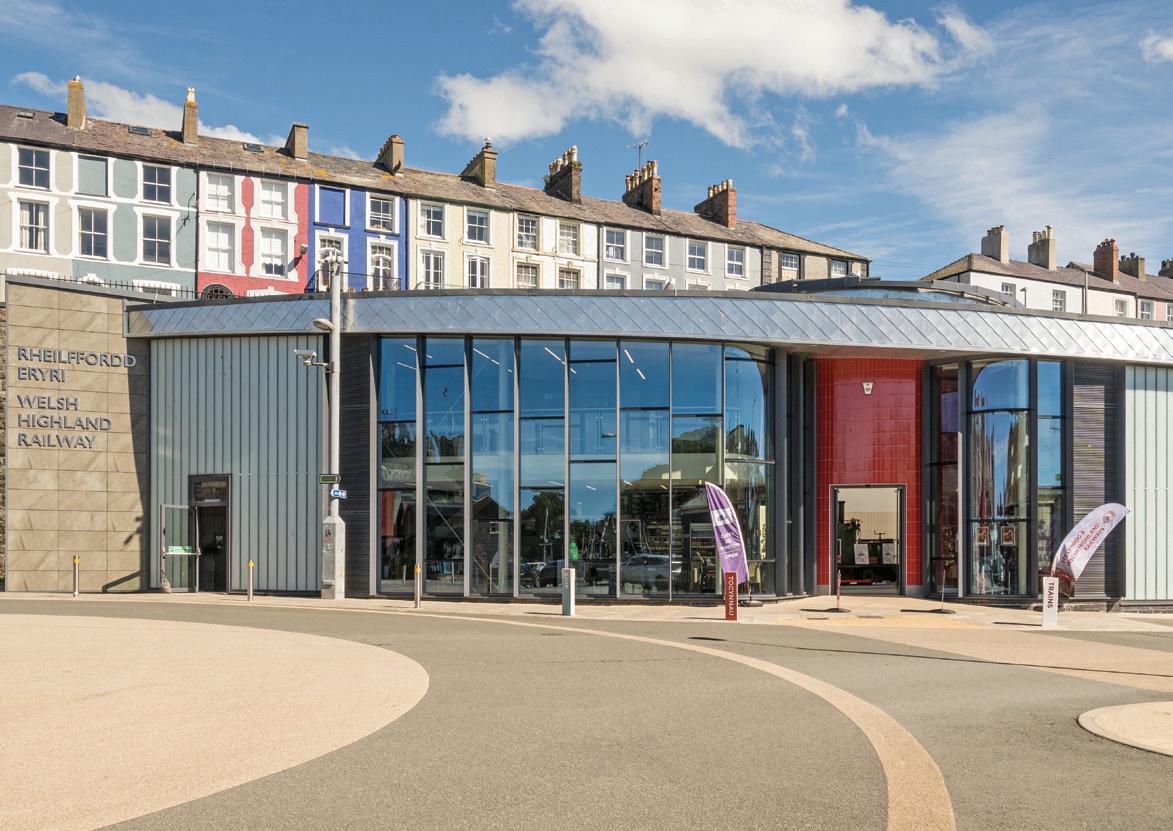
26

27
The new station building at Caernarfon has been specifically designed to meet the needs of a 21st century clientele. (John Dobson)
